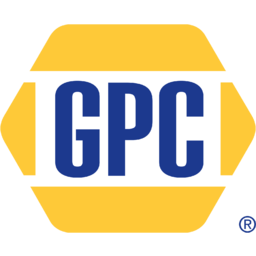
P/E ratio for Genuine Parts Company (GPC)
P/E ratio as of April 2024 (TTM): 18.1
According to Genuine Parts Company 's latest financial reports and stock price the company's current price-to-earnings ratio (TTM) is 18.0978. At the end of 2022 the company had a P/E ratio of 20.8.
P/E ratio history for Genuine Parts Company from 2001 to 2023
PE ratio at the end of each year
| Year | P/E ratio | Change |
|---|---|---|
| 2022 | 20.8 | -7.18% |
| 2021 | 22.4 | -104.45% |
| 2020 | -502 | -2113.71% |
| 2019 | 24.9 | 43.62% |
| 2018 | 17.4 | -23.43% |
| 2017 | 22.7 | 9.41% |
| 2016 | 20.7 | 11.96% |
| 2015 | 18.5 | -19.41% |
| 2014 | 23.0 | 22.31% |
| 2013 | 18.8 | 22.87% |
| 2012 | 15.3 | -9.85% |
| 2011 | 17.0 | -0.61% |
| 2010 | 17.1 | 12.78% |
| 2009 | 15.1 | 17.04% |
| 2008 | 12.9 | -16.83% |
| 2007 | 15.5 | -9.26% |
| 2006 | 17.1 | -1.75% |
| 2005 | 17.4 | -10.6% |
| 2004 | 19.5 | 13.33% |
| 2003 | 17.2 | -108.94% |
| 2002 | -192 | -1002.18% |
| 2001 | 21.3 |
P/E ratio for similar companies or competitors
| Company | P/E ratio | P/E ratio differencediff. | Country |
|---|---|---|---|
 Advance Auto Parts
AAP | 12.9 | -28.95% | 🇺🇸 USA |
 LKQ Corporation LKQ | 12.0 | -33.57% | 🇺🇸 USA |
 O'Reilly Automotive ORLY | 27.8 | 53.48% | 🇺🇸 USA |
 Snap-on SNA | 14.4 | -20.47% | 🇺🇸 USA |
 CarParts.com
PRTS | -8.13 | -144.94% | 🇺🇸 USA |
 Dorman Products DORM | 28.6 | 58.15% | 🇺🇸 USA |
 Standard Motor Products (SMP) SMP | 19.6 | 8.10% | 🇺🇸 USA |
How to read a P/E ratio?
The Price/Earnings ratio measures the relationship between a company's stock price and its earnings per share. A low but positive P/E ratio stands for a company that is generating high earnings compared to its current valuation and might be undervalued. A company with a high negative (near 0) P/E ratio stands for a company that is generating heavy losses compared to its current valuation.
Companies with a P/E ratio over 30 or a negative one are generaly seen as "growth stocks" meaning that investors typically expect the company to grow or to become profitable in the future.
Companies with a positive P/E ratio bellow 10 are generally seen as "value stocks" meaning that the company is already very profitable and unlikely to strong growth in the future.